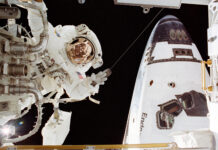Parker Solar Probe’s Upcoming Perihelion: A Closer Look at Its Groundbreaking Mission
The Parker Solar Probe, a pioneering spacecraft launched by NASA with the aim of studying the Sun, is set to reach its closest approach, known as perihelion, on December 24, 2024. This event marks a significant milestone in its mission to gather unprecedented data about our nearest star. However, during this close encounter, mission control will not be able to communicate with the spacecraft due to its proximity to the Sun, which will interfere with radio signals.
The spacecraft is expected to establish contact again by sending a beacon signal on December 27, 2024. This signal will serve as a confirmation of its successful passage through perihelion and provide information about the spacecraft’s health and functionality. After this critical moment, the Parker Solar Probe will continue its orbit around the Sun, completing two additional perihelia at the same distance before concluding its mission.
Understanding the Parker Solar Probe’s Mission
Launched in 2018, the Parker Solar Probe represents a monumental leap in solar exploration. Its primary objective is to study the outer corona of the Sun and to understand the solar winds, magnetic fields, and energetic particles emitted from our star. These elements significantly impact space weather, which can affect satellite operations, communications systems, and even power grids on Earth.
The probe is equipped with a suite of scientific instruments designed to measure magnetic fields, plasma waves, and high-energy particles. The data collected by these instruments help scientists gain insights into the Sun’s behavior and its influence on the solar system.
Technical Aspects and Challenges
The Parker Solar Probe must endure extreme conditions as it approaches the Sun. The spacecraft is outfitted with a cutting-edge heat shield, known as the Thermal Protection System (TPS), which allows it to withstand temperatures reaching up to 2,500 degrees Fahrenheit (approximately 1,377 degrees Celsius). This heat shield is a marvel of engineering, made from a carbon-composite material that effectively protects its scientific instruments from the intense heat and radiation.
One of the significant challenges faced by the probe is maintaining communication with mission control. As the spacecraft gets closer to the Sun, the solar radio emissions can interfere with the signals sent and received by the probe. During these periods, the Parker Solar Probe operates autonomously, relying on pre-programmed commands to carry out its scientific duties and ensure its safety.
The Importance of Parker’s Discoveries
The findings from the Parker Solar Probe have already started to reshape our understanding of the Sun. By getting closer to the Sun than any spacecraft before, it provides a unique opportunity to observe solar phenomena directly from the source. For instance, the probe’s data has contributed to a better understanding of how solar winds are accelerated and how the Sun’s magnetic field structures the heliosphere, the vast bubble of space influenced by solar winds.
These insights are critical as they help scientists predict space weather events more accurately. Such events, like solar flares and coronal mass ejections, can have significant effects on Earth, disrupting satellite communications and navigation systems. By understanding the conditions that lead to these events, scientists can develop more robust models to predict them, potentially mitigating their impact.
What to Expect Moving Forward
As the Parker Solar Probe continues its journey, it promises to deliver more groundbreaking discoveries. The data gathered from its subsequent perihelia will enhance our comprehension of the Sun’s dynamics and its interaction with the solar system. This mission not only helps scientists unravel the mysteries of our solar system’s star but also paves the way for future missions that could explore other stars and stellar phenomena.
Conclusion
The Parker Solar Probe’s upcoming perihelion on December 24, 2024, is an exciting event in the field of solar research. As it journeys closer to the Sun than ever before, it provides an unparalleled opportunity to deepen our understanding of solar processes and their impact on space weather. The mission exemplifies human ingenuity and the relentless pursuit of knowledge, reminding us of the vast and intriguing universe that surrounds us.
For more information about the Parker Solar Probe and its mission, you can visit NASA’s official website. Keep an eye on this remarkable mission as it continues to unveil the secrets of our Sun.
For more Information, Refer to this article.


































